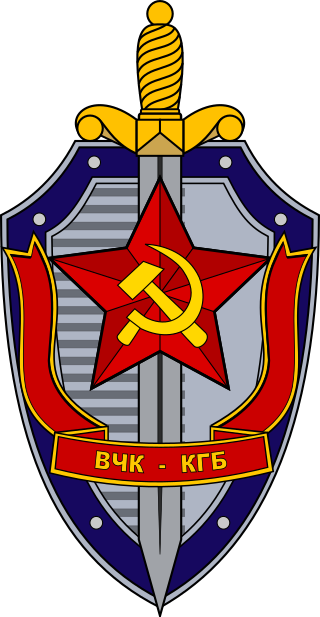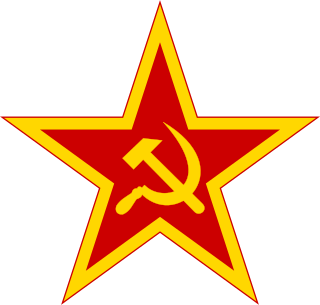
The Armed Forces of Turkmenistan, known informally as the Turkmen National Army is the national military of Turkmenistan. It consists of the Ground Forces, the Air Force and Air Defense Forces, Navy, and other independent formations.
Military science is the study of military processes, institutions, and behavior, along with the study of warfare, and the theory and application of organized coercive force. It is mainly focused on theory, method, and practice of producing military capability in a manner consistent with national defense policy. Military science serves to identify the strategic, political, economic, psychological, social, operational, technological, and tactical elements necessary to sustain relative advantage of military force; and to increase the likelihood and favorable outcomes of victory in peace or during a war. Military scientists include theorists, researchers, experimental scientists, applied scientists, designers, engineers, test technicians, and other military personnel.

Nikolai Vasilyevich Ogarkov was a prominent Soviet military personality. He was promoted to Marshal of the Soviet Union in 1977. Between 1977 and 1984, he was Chief of the General Staff of the USSR. He became widely known in the West when he became the Soviet military's spokesman following the shootdown of Korean Air Lines Flight 007 near Moneron Island in September 1983. He was dismissed as Chief of the General Staff on 6 September 1984.

The Military Academy of the General Staff of the Armed Forces of the Russian Federation is the senior staff college of the Russian Armed Forces.

The Rear of the Armed Forces of the Russian Federation (RAF-RF), often referred to in English as the rear services, was an organization of support services for the Russian Armed Forces until 2010 when it was transformed into Logistical Support of the Russian Armed Forces.

The Ministry of Defence of the Russian Federation is the governing body of the Russian Armed Forces.

Soviet Military Power was a public diplomacy publication of the US Defense Intelligence Agency (DIA), which provided an estimate of the military strategy and capabilities of the Soviet Union during the final years of the Cold War, ostensibly to alert the US public to the significant military capabilities of the Soviet Armed Forces. First published in early October 1981, it became an annual publication from 1983 until the collapse of the Soviet Union in 1991. Already in draft as the Soviet Union collapsed, the 1991 version was retitled "Military Forces in Transition". In addition to the majority English version, Soviet Military Power was translated, printed, and disseminated in a variety of languages, including German, French, Japanese, Italian, and Spanish.

The Military-Industrial Commission of the Russian Federation was established by a presidential decree in March 2006. According to the decree, it is a permanently functioning body with vast responsibilities for supervising the distribution and implementation of the "State defense order". The commission answers directly to the President of Russia. It coordinates between the Defence Ministry of the Russian Federation, the Armed Forces of the Russian Federation, and the defense industry of Russia. Until then, the defense industry was supervised by Russia's Ministry of Industry and Energy, as well as by the previous government consultative body with a similar name.

The General Staff of the Armed Forces of the Russian Federation is the military staff of the Russian Armed Forces. It is the central organ of the military command of the Armed Forces Administration and oversees operational command of the armed forces under the Russian Ministry of Defence.
The military modernization program of the People's Liberation Army (PLA) which began in the late 1970s had three major focuses. First, under the political leadership of 3rd paramount leader Deng Xiaoping, the military became disengaged from civilian politics and, for the most part, resumed the political quiescence that characterized its pre-Cultural Revolution role. Deng reestablished civilian control over the military by appointing his supporters to key military leadership positions, by reducing the scope of the PLA's domestic non-military role, and by revitalizing the party political structure and ideological control system within the PLA.
With Europe stabilizing along the Iron Curtain, the CIA attempted to limit the spread of Soviet influence elsewhere around the world. Much of the basic model came from George Kennan's "containment" strategy from 1947, a foundation of US policy for decades.
The Ministry of Defense was a government ministry in the Soviet Union, which supervised the Soviet Armed Forces. The first Minister of Defense was Nikolai Bulganin, starting 1953. Krasnaya Zvezda was the "central organ" - official newspaper of the Ministry.

The Committee for State Security (CSS) was the main security agency for the Soviet Union from 13 March 1954 until 3 December 1991. As a direct successor of preceding agencies such as the Cheka, GPU, OGPU, NKGB, NKVD and MGB, it was attached to the Council of Ministers. It was the chief government agency of "union-republican jurisdiction", carrying out internal security, foreign intelligence, counter-intelligence and secret police functions. Similar agencies operated in each of the republics of the Soviet Union aside from the Russian SFSR, where the KGB was headquartered, with many associated ministries, state committees and state commissions.
Academy of Military Science is a Russian non-governmental research interregional public organization. Conducts basic and applied military research, and has headquarters in Moscow.

Disinformation: Former Spy Chief Reveals Secret Strategies for Undermining Freedom, Attacking Religion, and Promoting Terrorism is a 2015 non-fiction book about disinformation tactics and history rooted in information warfare. It was written by former general in the Securitate, the secret police of Socialist Republic of Romania, Ion Mihai Pacepa, and law professor Ronald J. Rychlak. It was published in 2013 along with a companion film, Disinformation: The Secret Strategy to Destroy the West.
Basic intelligence is fundamental or factual information about a foreign country, organization or issue that is collected and produced in intelligence reports by an intelligence organization. In the U.S. Intelligence Community, the CIA World Factbook is the best known basic intelligence publication. The U.S. Department of Defense uses the term "General Military Intelligence" for military basic intelligence.

"Military Affairs" was a popular Russian-language military (military-scientific) magazine on military affairs, the press organ of the People's Commissariat for Military and Naval Affairs on the part of the General Staff. It was published once a week. Until 1920, it was the only periodical in Russia designed for a wide range of readers and was intended for the command and political composition of the Workers' and Peasants' Red Army.
The Russian Academy of Rocket and Artillery Sciences (RARAN) is a non-profit scientific organization of the Russian Federation. RARAN coordinates the activities of scientists who carry out complex research and development (R & D) on the creation, operation and use of modern weapons, military technology and special equipment. The Academy was established on April 5, 1994 by a decree of the RF President "in order to revive the traditions of Russian military science, and to develop scientific research in the country's defense complex". RARAN is the only scientific and expert organization in the power structures that has state status. It unites leading scientists and specialists from organizations of the Russian Ministry of Defense, other federal executive authorities and the defense industry. This union enables the solutions of problematic issues such as the systemic development of weapons and special military technology (VVST). According to its legal form, RARAN is a federal state budgetary institution. By the Decree of the RF Government on July 17, 1995 No. 715, RARAN was equated with branch academies. The principles of activity and its numbers were determined: 100 full members and 200 corresponding members. In addition, the charter provides for the possibility of electing honorary and foreign members. Since 2016, according to the decision of the board of the RF Military-Industrial Commission, RARAN was designated the head scientific organization for the Council of Chief Designers of the weapons systems of the Army. The President of the Academy was also appointed the head of this council.
Pyotr Ivanovich Ivashutin was a Soviet Army General and head of the state and military security organs, who was deputy chairman of the KGB (1954-1963), temporary acting head of the KGB in 1961 and the longest running head of the GRU.

The United Armed Forces of the Commonwealth of Independent States was a short-lived military entity associated with the Commonwealth of Independent States. It was created in 1992 after the demise of the Soviet Union, and was intended to be the continuation of the Soviet Armed Forces and to hold control over the Soviet Union's nuclear weapons.












